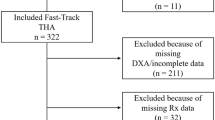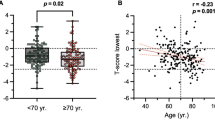Abstract
Purpose
The goal of the study was to analyze the impact of the pre-operative bone mineral density on the patients’ reported outcomes at two year minimum follow-up of cementless THA using a proximally fixed anatomic stem.
Methods
A prospective study included all patients who underwent a cementless THA using a specific proximally fixed anatomic stem and a 3D preoperative CT scan-based planning. The bone mineral density (BMD) of the metaphyseal cancellous bone was computed in a volume (of 1 mm thick and of 1 cm2 surface) at the level of the calcar 10 mm above the top of the lesser trochanter. Patients were assessed at two year follow-up using self-administered auto-questionnaires corresponding to the modified Harris (mHHS), the Oxford (OHS), and the Forgotten Hip (FHS) scores. A multiple linear regression statistical analysis was performed to assess the link between the mHHS, the age, body mass index (BMI), BMD, gender, and ASA grade.
Results
Fifty patients were included (29 men, 21 women), with an average age of 62 ± 12 years and an average BMI of 27 ± 5 kg/m2. At two year follow-up, on multivariate analysis, excellent mHHS (≥ 90%) was significantly associated with only two parameters: a BMI ≤ 25 kg /m2 with an odd ratio OR = 10 (CI95% [2.1–48.3], p = 0.004) and a BMD ≥ 72 mg/cm3 with an odd ratio OR = 4.87 (CI95% [1.2–18.6], p = 0.02).
Conclusion
The short-term PROMs after cementless THA are impacted by pre-operative cancellous bone density. However, the BMI remains the most influential parameter on the clinical outcomes.








Similar content being viewed by others
References
Pilliar RM, Lee JM, Maniatopoulos C (1986) Observations on the effect of movement on bone ingrowth into porous-surfaced implants. Clin Orthop Relat Res (208):108–113
Gabet Y, Kohavi D, Voide R, Mueller TL, Muller R, Bab I (2010) Endosseous implant anchorage is critically dependent on mechanostructural determinants of peri-implant bone trabeculae. J Bone Miner Res 25:575–583. https://doi.org/10.1359/jbmr.090808
Aro HT, Alm JJ, Moritz N, Makinen TJ, Lankinen P (2012) Low BMD affects initial stability and delays stem osseointegration in cementless total hip arthroplasty in women: a 2-year RSA study of 39 patients. Acta Orthop 83:107–114. https://doi.org/10.3109/17453674.2012.678798
Maier GS, Kolbow K, Lazovic D, Maus U (2016) The importance of bone mineral density in hip Arthroplasty: results of a survey asking orthopaedic surgeons about their opinions and attitudes concerning osteoporosis and hip arthroplasty. Adv Orthop 2016:8079354. https://doi.org/10.1155/2016/8079354
Sariali E, Mauprivez R, Khiami F, Pascal Moussellard H, Catonne Y (2012) Accuracy of the preoperative planning for cementless total hip arthroplasty. A randomised comparison between three-dimensional computerised planning and conventional templating. Orthop Traumatol Surg Res 98:151–158
Sariali E, Catonne Y, Pascal-Moussellard H (2017) Three-dimensional planning-guided total hip arthroplasty through a minimally invasive direct anterior approach. Clinical outcomes at five years' follow-up. Int Orthop 41:699–705. https://doi.org/10.1007/s00264-016-3242-z
Aro E, Alm JJ, Moritz N, Mattila K, Aro HT (2018) Good stability of a cementless, anatomically designed femoral stem in aging women: a 9-year RSA study of 32 patients. Acta Orthop 89:490–495. https://doi.org/10.1080/17453674.2018.1490985
Sariali E, Mouttet A, Mordasini P, Catonne Y (2012) High 10-year survival rate with an anatomic cementless stem (SPS). Clin Orthop Relat Res 470:1941–1949. https://doi.org/10.1007/s11999-012-2300-0
Klouche S, Giesinger JM, Sariali EH (2018) Translation, cross-cultural adaption and validation of the French version of the Forgotten Joint Score in total hip arthroplasty. Orthop Traumatol Surg Res 104:657–661. https://doi.org/10.1016/j.otsr.2018.04.010
Cohen (1988) Statistical power analysis for the behavioral sciences,, , , 1988]. Lawrence Erlbaum Associates, Hillsdale
Swets JA (1988) Measuring the accuracy of diagnostic systems. Science 240:1285–1293. https://doi.org/10.1126/science.3287615
Ragab AA (2003) Validity of self-assessment outcome questionnaires: patient-physician discrepancy in outcome interpretation. Biomed Sci Instrum 39:579–584
Gross TP, Liu F (2012) Risk factor analysis for early femoral failure in metal-on-metal hip resurfacing arthroplasty: the effect of bone density and body mass index. J Orthop Surg Res 7:1. https://doi.org/10.1186/1749-799X-7-1
El-Daly I, Rondon A, Pinto S, Grimal Q, Sariali E (2020) Modification of regional bone mineral density due to femoral rasping in cementless proximally fixed total hip arthroplasty. Orthop Traumatol Surg Res. https://doi.org/10.1016/j.otsr.2019.11030
Shibuya M, Nanri Y, Kamiya K, Fukushima K, Uchiyama K, Takahira N, Takaso M, Fukuda M, Matsunaga A (2020) The maximal gait speed is a simple and useful prognostic indicator for functional recovery after total hip arthroplasty. BMC Musculoskelet Disord 21:84. https://doi.org/10.1186/s12891-020-3093-z
Meessen J, Fiocco M, Tordoir RL, Sjer A, Verdegaal SHM, Slagboom PE, Vliet Vlieland TPM, Nelissen R (2020) Association of handgrip strength with patient-reported outcome measures after total hip and knee arthroplasty. Rheumatol Int 40:565–571. https://doi.org/10.1007/s00296-020-04532-5
Holsgaard-Larsen A, Hermann A, Zerahn B, Mejdahl S, Overgaard S (2020) Effects of progressive resistance training prior to total HIP arthroplasty - a secondary analysis of a randomized controlled trial. Osteoarthr Cartil. https://doi.org/10.1016/j.joca.2020.04.010
Sariali E, Knaffo Y (2017) Three-dimensional analysis of the proximal anterior femoral flare and torsion. Anatomic bases for metaphyseally fixed short stems design. Int Orthop 41:2017–2023. https://doi.org/10.1007/s00264-017-3435-0
Dessyn E, Flecher X, Parratte S, Ollivier M, Argenson JN (2019) A 20-year follow-up evaluation of total hip arthroplasty in patients younger than 50 using a custom cementless stem. Hip Int 29:481–488. https://doi.org/10.1177/1120700018803290
Funding
No external funding sources were provided for this study.
Author information
Authors and Affiliations
Corresponding author
Ethics declarations
Conflict of interest
Intellectual property rights: royalties from Symbios SA.
Ethical approval
The study was approved by the local ethical committee.
Ethical committee
The study was approved by the local ethical committee. All of the patients provided informed consent to participate in the study.
Informed consent
All of the patients provided informed consent to participate in the study.
Additional information
Publisher’s note
Springer Nature remains neutral with regard to jurisdictional claims in published maps and institutional affiliations.
Level of Evidence: Therapeutic Level II
Rights and permissions
About this article
Cite this article
Sariali, E., Gaujac, N., Grimal, Q. et al. Pre-operative bone mineral density is a predictive factor for excellent early patient-reported outcome measures in cementless total hip arthroplasty using a proximally fixed anatomic stem. A prospective study at two year minimum follow-up. International Orthopaedics (SICOT) 44, 2253–2259 (2020). https://doi.org/10.1007/s00264-020-04683-x
Received:
Accepted:
Published:
Issue Date:
DOI: https://doi.org/10.1007/s00264-020-04683-x




